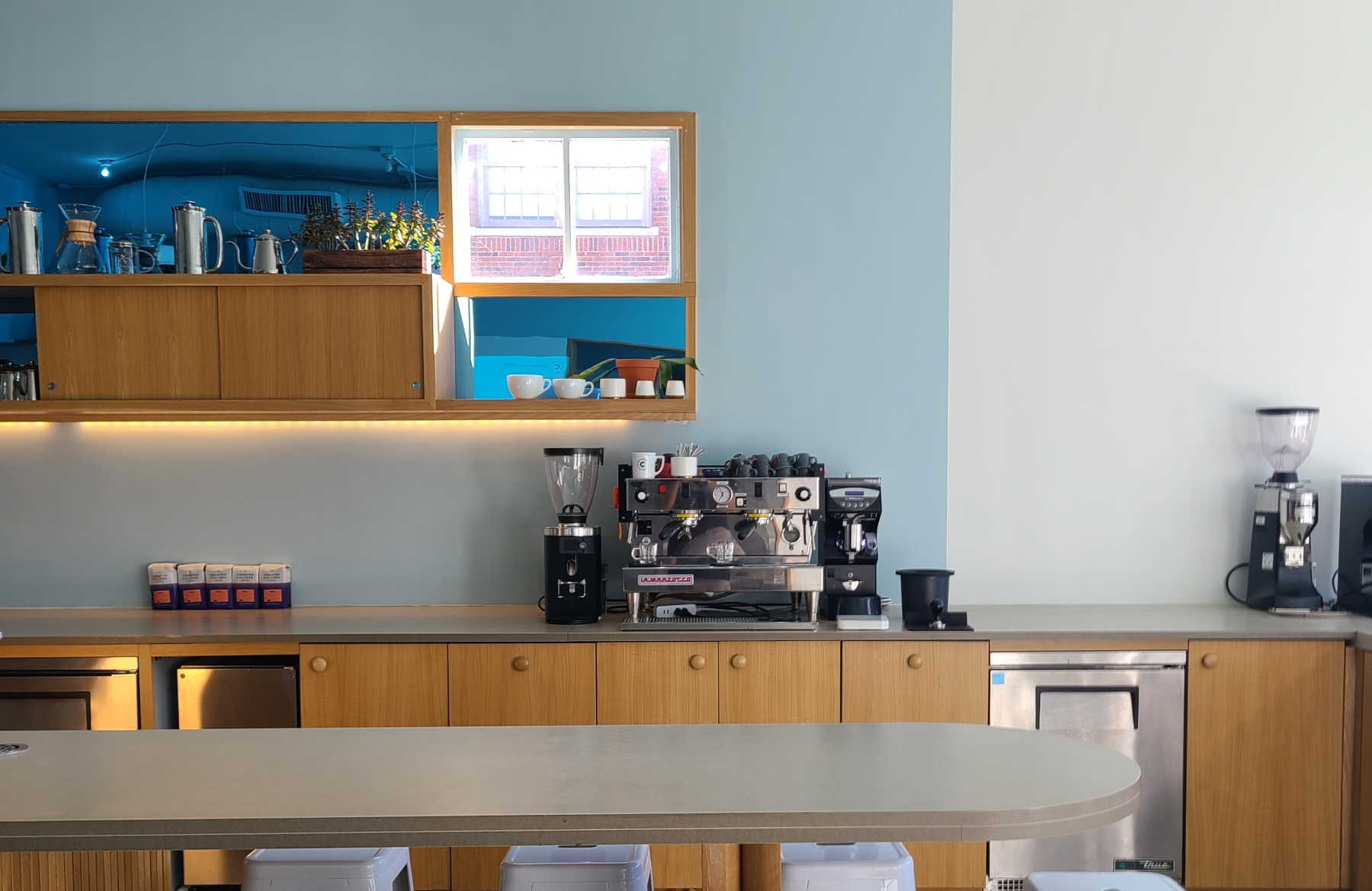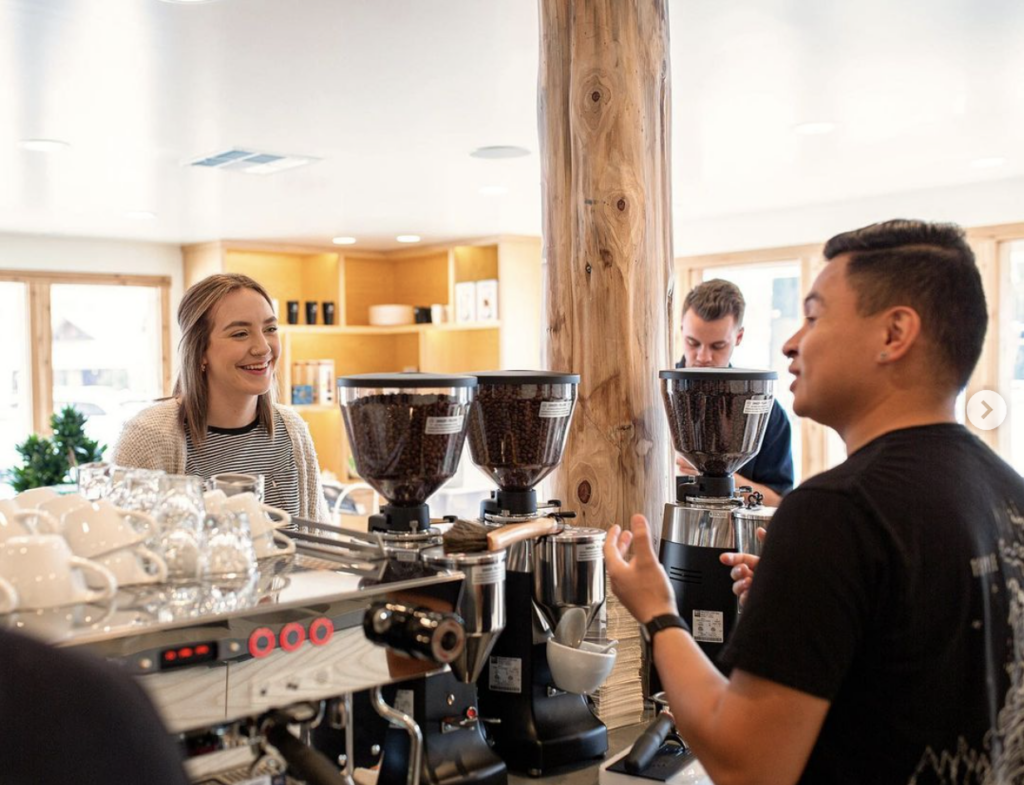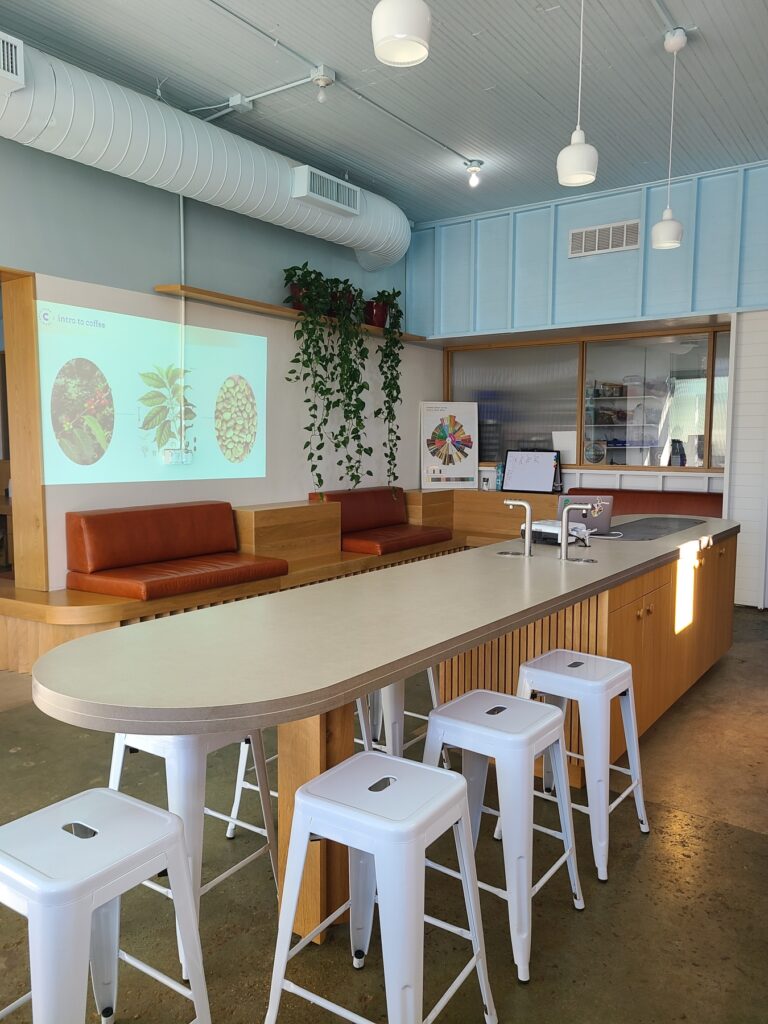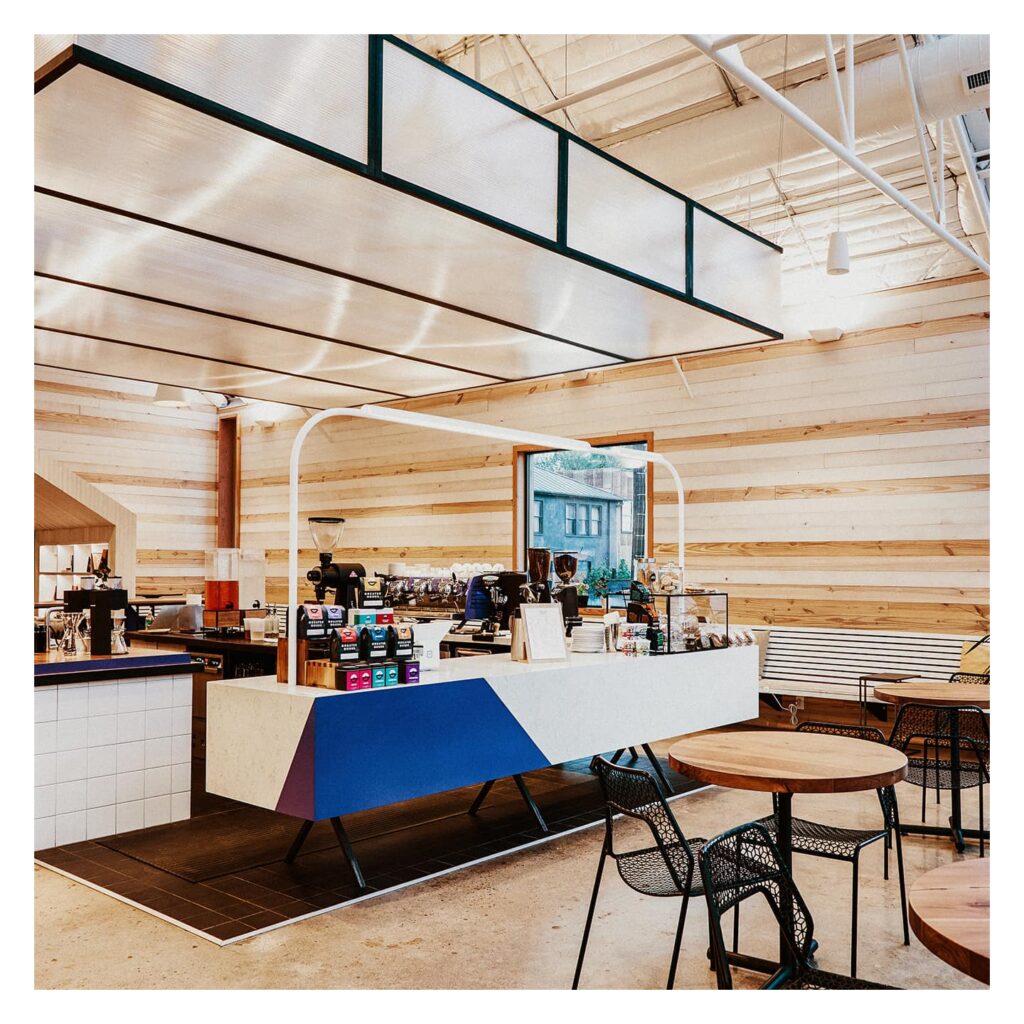A well-oiled machine. An intricate dance. Taking the first bite of a meal you worked on all day. Pure magic. This is how barista trainers describe efficiency behind the bar, and witnessing an efficient coffee service is like watching a card trick up close. Every single move is effortless and mesmerizing, and before you can blink, there’s a queen of hearts (or a cappuccino) in your hands.
The first time I stepped behind an espresso machine, I unlocked the portafilter and let it fall onto the drip tray with a clunk. My shots channeled, my milk scorched, and I spilled drinks often. I tried not to cry when more experienced baristas took over during the rush, tossing espresso into paper cups like balls into baskets. My coworkers told me to be patient and that speed would come with time. The more you do it, the faster you’ll get.
That was almost seven years ago, and now, as the head trainer for Greater Goods Coffee in Austin, Texas, I still find that efficiency is one of the most challenging things to teach. It’s complicated and difficult to conceptualize, with no cut-and-dry method of measuring success. But when it does finally click, when your muscles succumb to memory and your brain fires on all cylinders and hours feel like minutes, it’s bliss—and also key to running a successful cafe.
So how do we become more efficient? Does it really just come with time? Must we make four drinks in five minutes to prove it? Or is there some secret formula to train efficiency more efficiently?
Definition, Please?
Efficiency is an ambiguous, highly subjective concept. There are many factors to consider, not the least of which is the actual definition of the word as it pertains to your cafe.
“It’s not a one-size-fits-all type of idea,” said Kyle Conner, senior training manager for Colectivo Coffee Roasters. He oversees barista education for 20 stores in three markets, plus wholesale clients across the Midwest. Each Colectivo location has its own unique rhythm and energy, which is very on-brand but also logistically challenging, training-wise.
But Conner doesn’t let that get in the way. “Given the circumstances, we find the right equation that allows our staff members to work in an environment that isn’t stressful, allows them to create beverages and complete orders without worry, and still lends itself to a space where the teams can grow and learn from each other,” he said.
For Ali Abderrahman, regional educator for Counter Culture Coffee in Dallas, efficiency is a two-way street. It’s not only how the barista feels about getting drinks out, he says, but how the guests feel about their experience ordering and receiving a drink.
“If we’re honest about what most customers want from our coffee shops, it’s good service delivered efficiently,” he said. “To me, if everyone gets the correct drink in a reasonable amount of time without confusion, that’s a success.”
Although the exact amount of time it should take to make a drink is up for debate, efficiency is never about speed alone. Efficiency is the ability to make delicious, accurate, beautiful drinks swiftly; to move with intention, confidence, and cleanliness. It means baristas feel prepared and supported, and guests feel their wait times are justified.
Efficient Metrics
I once overheard a Greater Goods (GG) customer say our cafe was like the Franklin Barbecue of coffee. Franklin’s is the premier barbecue spot in Austin, and folks will literally camp out to save their places in line, waiting up to five hours for a pound of brisket. It was a harsh review (our line usually takes twenty minutes to move through during peak hours), but it motivated us to pause and reconsider what efficient service should look like at our cafe.
Like many shops, GG is way busier now than during the pandemic. It’s been a game of catch-up to try and adjust to the new pace, and as the seasons change and the tourists flock to sunny, warm Austin, efficiency has been top of mind. From the uptick in business and similar guest feedback about long wait times, we realized a major hang-up was happening at the register.
A lone cashier was responsible for taking the orders, grabbing pastries, starting pour overs and teas, and serving cold brew and drip coffee. They constantly had to step away to do other tasks, leaving behind a long line of impatient customers. Our most popular drinks are hot coffee and cold brew, so a lot of the time, there’d be more people waiting in line to order than waiting for their espresso drinks.
Inefficiencies like this, once identified, present a beautiful opportunity for problem-solving. So we experimented. We redefined some roles behind the bar and shifted another barista to the register to help with the workload. We also put out a QR code customers can scan to view the menu while they wait. After a few shifts, the flow started to feel smoother, the guests were happier, and tips were higher. It felt like a win, but efficiency training is never over. We constantly learn, unlearn, and adapt because that’s our job in an ever-changing industry.
We track our success anecdotally at GG, but metrics can also come from more concrete data, like transaction times. The magic number for Temple Coffee Roasters in Sacramento, Calif., is 60 seconds per transaction. According to Elise Jones, Temple’s director of education, analytics are regularly pulled for employee and store evaluations.
“Tracking transaction times helps us gauge what may be causing a delay in the flow of the line,” she says. “We can pinpoint the issues and implement new policies, then see improvements in the numbers.”
Doing things more efficiently doesn’t always mean doing them faster, however.
“Ultimately, success is gauged not by how quickly we can get customers in and out,” says Jones, “but by serving tasty beverages and adapting experiences to meet guests’ needs.”
Laying It Out
A well-designed cafe is the literal building block for efficiency. A common concept for coffee shop layout is to follow the natural flow of drink preparation:
- Guests line up at the register and order their drinks from a cashier.
- A barista stands a few feet away with a stack of cups and the grinders, followed by the espresso machine, pitcher rinser, and pickup counter.
- She prepares the shot, reaches for a pitcher of cold milk, steams it, and pours it on top of the espresso.
- She serves the drink at the end of the bar, where the guest has been waiting, then starts the following order.
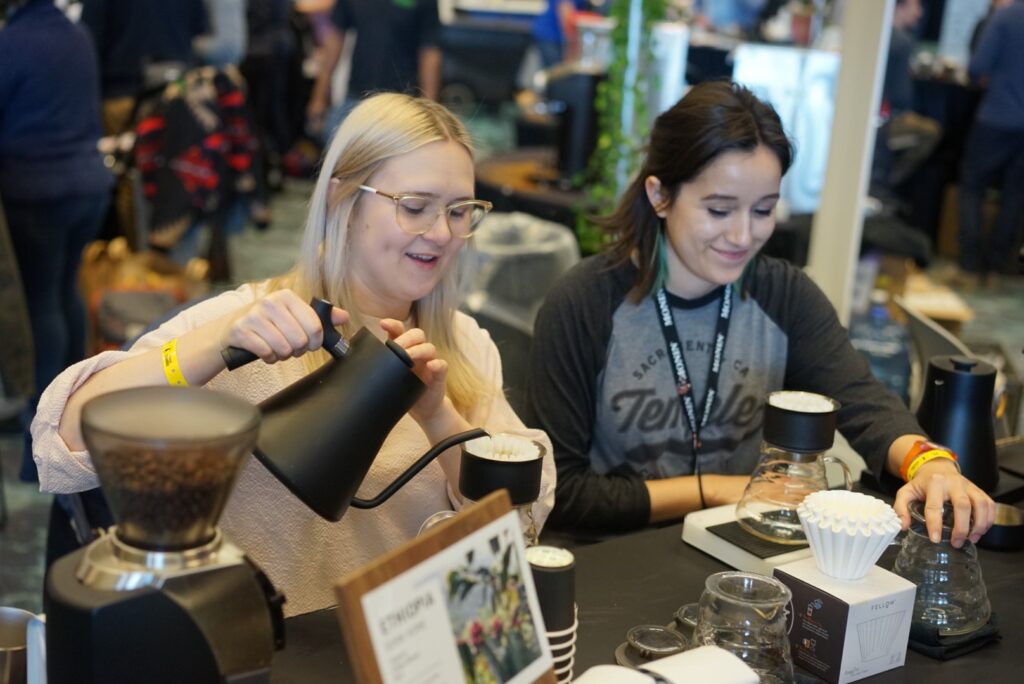
Temple takes a different approach: the queue starts at the espresso machine and ends at the register. The barista is the first point of contact for the customer; they take the order, make the drink, and pass everything off to the cashier to finish the transaction. As part of their training, Temple baristas are given prompts and conversational tools to engage guests while they work.
“We believe it to be the most efficient, yes, but more importantly, this system allows for a built-in service experience,” says Jones. “I’ve noticed people are much happier to wait, or ideally don’t feel like they are waiting at all, if the service is great.”
While you may feel inclined to rip out your bar and start from scratch, you can do plenty of things to improve workflow with a less-than-ideal cafe layout. Maybe you can’t move your espresso machine, but how about the cups, syrups, or pastry case? Abderrahman recommends observing workflow, noticing where the hang-ups are, and then working with owners and managers to rearrange what you can. Try it and see! You can always move things back.
Staff It Up
During the interview process, it’s helpful to be as transparent as possible about the volume of your cafe and efficiency expectations, says Katie Thomas, senior manager of training and quality assurance for La Colombe. This applies to everyone, from managers to prospective baristas.
“High volume is not for everyone,” she says. It’s important to remember that high volume doesn’t mean the same thing to everyone. Lucky for Thomas, La Colombe has multiple locations in cities like Philadelphia, New York City, and Washington, DC, so baristas can be moved to other sites if the workload isn’t a good fit. “Everyone responds differently to the needs of the cafe.”
Whenever possible, managers should aim to create schedules that promote efficiency. Tools like Square and Toast can track peak hours, so daily rushes shouldn’t be a surprise. Make sure you’re fully staffed when and where it counts, and play to the individual strengths of each team member.
Strategically pair newer baristas with shift leads, or schedule them for sleepy Sunday afternoons until they feel confident enough to tackle the morning rush. Try not to schedule too many closing and opening shifts back-to-back. If you have the privilege of a fully staffed cafe, asks Conner, why not use it to your advantage?
“As little as it may be to some, these things can make or break a person’s shift,” he says, pointing out that inefficiency might not be an individual problem, but a staffing and logistics mismatch. “Longer wait times might be because there wasn’t a barback when there should’ve been.”
Locked And Loaded
Before the rush, I like to play a game called “Worst Case Scenario.”
It goes like this: What’s the worst thing that can happen if we have a line wrapped around the building? What if you kicked the drip coffee urn and didn’t have a backup batch brewed? Brew it now while it’s slow. What if you run out of pastry bags? Run to the back and get some during a lull before it’s too late. What if we’re down to our last two grams of matcha? Don’t wait until you’re scraping the bottom of the canister to refill it! It doesn’t matter how many cappuccinos you can make in five minutes if you run out of milk in the middle of an endless line. When there’s time, use it to prepare for the next time there is no time.
The role of the barista is to make quality drinks efficiently and consistently, and none should suffer for the sake of another. Just as quality and consistency are habits that must be developed and taught, so must efficiency. It will not come naturally to everyone, but it’s crucial to set baristas up for success before holding them responsible for inefficient service. Clearly define what efficiency means for your cafe, and set actionable goals with metrics for success. Identify areas of improvement for the bar layout, equipment, or tools.
Cover photo by Ali Abderrahman
Miranda Haney (she/her) is a writer, musician, and coffee teacher based in Austin, Texas. She’s currently the head trainer and events coordinator for Greater Goods Coffee. When she’s not doing coffee things, she’s probably running a marathon (or something crazy like that).

